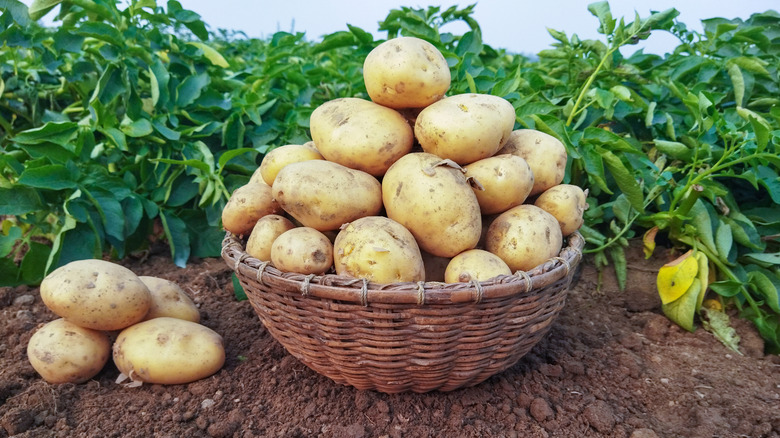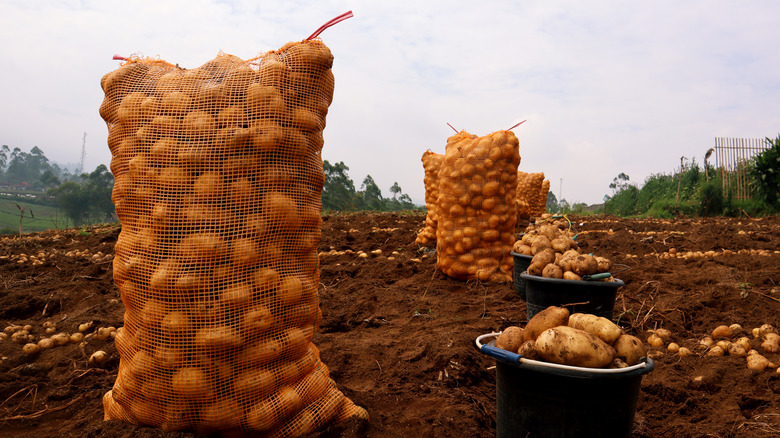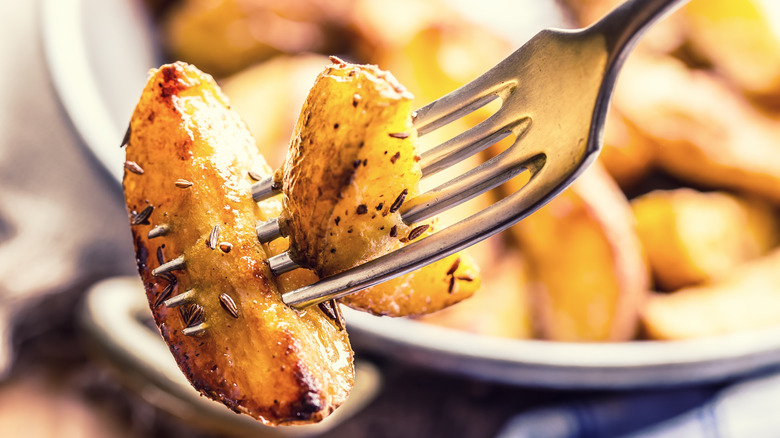How The Potato Became A Global Staple
Potatoes aren't exactly a showstopping ingredient. On their own, they tend to be fairly bland, in desperate need of butter, seasonings, or a bath in the deep fryer. Their presence on a menu is never a surprise, certainly not in the United States, but also around the globe. After all, potatoes are the fourth-most cultivated food crop worldwide, trailing only rice, wheat, and maize (corn), according to reporting from the BBC. Potatoes pop up in such a widely diverse array of dishes, from French Vichyssoise to Indian Aloo Gobi, that they don't seem to have an obvious homeland. In fact, it took years of genetic testing and archeological expeditions to determine where potatoes originated, but we ultimately found the answer.
It was long acknowledged that potatoes came from the Americas, a fact confirmed by genetic tests, according to the New York Times. However, it wasn't until 2016 that researchers were finally able to pinpoint their exact origin. Microscopic remains of potatoes found on ancient tools tell us that the crop is almost certainly native to the Andean highlands of southern Peru and has been cultivated by humans since at least 3400 B.C. Smithsonian Magazine is quick to point out how remarkable this discovery is, considering the extremely harsh climate of the Andes. The air is thin, temperatures can fluctuate from hot to freezing in a matter of hours, and the land is frequently beset by seismic activity. Yet this inauspicious soil birthed a root that would change the world.
The potato's journey around the world
Potatoes played a major role in the diets of the native Andean peoples, most famously the Inca. Per Smithsonian Magazine, potatoes were prepared in many ways in the Andes, including the familiar methods of boiling, baking, and mashing. One particularly notable dish is 'chuño,' made by naturally freeze-drying the potatoes in the hot-cold cycle of the Andean climate. This preserved the potatoes for years, becoming the primary food for Incan armies. Europeans got their hands on potatoes for the first time when those armies fell to the brutal attack of Spanish conquistador Francisco Pizarro in the mid-1500s.
The BBC explains that Spaniards brought not only potatoes but also tomatoes, avocados, and corn from the Americas to Europe. Potatoes didn't grow well in Spain's climate but prospered elsewhere, most notably in Ireland, where, by the 1700s, Smithsonian Magazine reports that 40% of people ate no solid food besides potatoes. Meanwhile, in France, a pharmacist named Antoine-Augustin Parmentier fashioned himself as the potato's version of Johnny Appleseed, planting acres of tubers around the country and hosting all-potato dinners for notable public figures, including Thomas Jefferson. The potato's popularity swiftly spread, and the BBC cites research suggesting potato cultivation led to a quarter of Europe's population growth between 1700 and 1900. As European nations proceeded to colonize other continents, they introduced potatoes to an ever-broader fanbase. But why were these root vegetables so popular in the first place? It's all about nutrition and convenience.
The power of potatoes
The biggest factor in potatoes' mass popularity is their nutrient content. Compared to rice, wheat, and corn, the only food crops that outsell it, the nutritious potato is a superior staple food. The BBC notes that potatoes contain all of the vital nutrients we need, with the only exceptions being vitamins A and D, which a bit of dairy in the diet can make up for. This explains how so many people were able to survive on potatoes alone, giving them unparalleled value in global cuisine.
Potatoes also had strategic value to peasant farmers. Smithsonian Magazine explains that potatoes are excellent for crop rotation, helping farmers make more efficient use of their land. This greatly reduced the frequency of famines among poor communities. The BBC adds that potatoes benefited peasants because they were much harder to tax under the punitive feudal system. Tax collectors could easily measure the yield of a wheat field because the plants grow above the surface, but since potatoes grow underground and out of sight, farmers could convince the collector they had fewer potatoes than they actually did. This same feature prevented invading armies, who often burned whole fields of crops during war, from causing too much damage to the food supply. While such issues aren't on many minds today, the cheap, nutrient-rich potato remains, as it always will, a friend to those in need.


